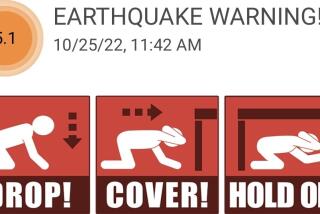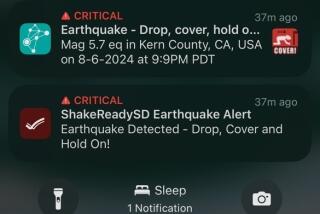Californians climb the learning curve for AMBER text alerts

Southern California residents got their first exposure to the new America’s Missing: Broadcast Emergency Response system Monday night, when their mobile phones suddenly displayed an alert telling them to be on the lookout for two children believed to have been abducted by the suspect in their mother’s fatal shooting.
Unfortunately, it delivered that message in AMBER-speak. The exact text: “Boulevard, CA AMBER Alert: LIC/6WCU986 (CA) Blue Nissan Versa 4 door.” On many phones, the message was accompanied by a warning tone loud enough to wake sleeping owners.
The Twitterverse responded with a mixture of confusion, irritation and outrage that anyone would be irritated. Oh and yes, the tastelessness that is Twitter. I lost count of how many tweets I saw about the alert that included “LOL” and “LMAO,” as if the idea of two kids being kidnapped by a suspected killer is worth a chuckle.
Inviting a response from fellow funnyman Michael Ian Black, actor Rainn Wilson tweeted early Tuesday morning, “Just got an amber alert and wondered what I should do @michaelianblack.” To which Black responded, “Stop, drop, and roll.” Black later deleted the tweet.
The irreverence and self-centeredness on display drew a proportionate response from Twitter scolds. Wrote Jonah Weiland: “Some people were angered by the AMBER ALERT text message that went out in California. Yet the constant reminders to play CANDY CRUSH are OK.”
Venture capitalist Eghosa Omoigui tried to put things in perspective, tweeting, “Ok, this amber alert may be annoying to many but this is for some real craziness. 2 dead (incl kid), 2 kids missing.” He included a link to a Washington Post story on the search for the children and their abductor.
The point, though, is that the system did what it was supposed to do: get people’s attention. In addition to the complaints and the rebuttals, Twitter was flooded with retweets about the alert and additional information, including pictures of the children -- Hannah and Ethan Anderson -- and their alleged kidnapper -- James Lee DiMaggio. Links to news stories about the case abounded as well. It was hard to be on Twitter in California and not know about the kidnapping and the suspected getaway car.
Most uses of the Emergency Broadcast System, such as tornado or flood warnings, are designed to help people look out for themselves. AMBER alerts, by contrast, try to get them to help someone else. It’s a crowdsourced solution to a daunting problem that police often don’t have the resources to solve.
The fact that the alerts were broadcast indiscriminately to San Diego-area cellphones (and later, to all California phones capable of receiving text messages, as the alert went statewide) clearly annoyed a lot of wireless customers. The system allows people to opt out of the alerts, but given that no one had received such a message before, it’s doubtful that anyone would have thought to do so before last night.
But the alerts can’t really be targeted if police don’t know where the kidnapper is, and it’s impossible to predict who might be in a position to help. So AMBER has to cast a wide net to have any hope of succeeding.
Yes, it might have helped if the message had been less cryptic. But now that we’ve all seen one, we should be able to recognize what such alerts are trying to tell us. If you’re out and about, look for a car matching the description and let the police know immediately if you see it. If not, recognize that the alert wasn’t meant for you and resume whatever you were doing, thankful that your family wasn’t the one that needed help.
ALSO:
Five reasons to stay away from Texas right now
Follow Jon Healey on Twitter @jcahealey and Google+
More to Read
A cure for the common opinion
Get thought-provoking perspectives with our weekly newsletter.
You may occasionally receive promotional content from the Los Angeles Times.











